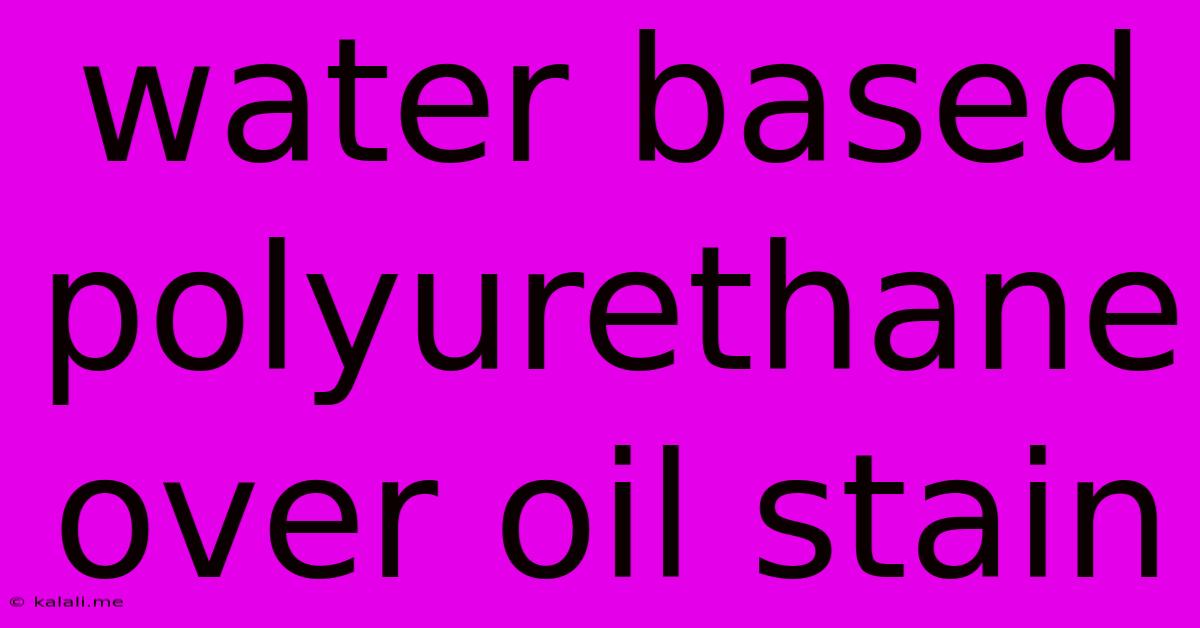Water Based Polyurethane Over Oil Stain
Kalali
May 23, 2025 · 3 min read

Table of Contents
Water-Based Polyurethane Over Oil Stain: A Comprehensive Guide
Meta Description: Learn the ins and outs of applying water-based polyurethane over oil-based stains. This guide covers prep work, application techniques, drying times, and troubleshooting common problems for a flawless finish.
Applying a protective topcoat over your beautifully stained wood is crucial for longevity and aesthetic appeal. While oil-based polyurethane was once the standard, water-based polyurethane has gained popularity due to its low odor, easy cleanup, and faster drying times. But can you apply water-based polyurethane over an oil-based stain? The short answer is yes, but with careful preparation and technique. This guide will walk you through the entire process, ensuring a smooth, durable, and professional-looking finish.
Understanding the Compatibility
The key to successfully layering water-based polyurethane over oil stain lies in understanding the chemical properties of both materials. Oil-based stains penetrate the wood, creating a color and providing some level of protection. Water-based polyurethane, on the other hand, forms a film on the surface. The challenge is ensuring proper adhesion between these two different types of finishes. While they are compatible, improper preparation can lead to peeling or bubbling.
Preparing Your Surface for Success
Thorough preparation is paramount for a successful finish. Neglecting this step is the most common reason for application failures. Here’s a detailed breakdown:
- Cleaning: Remove any dust, dirt, or debris from the stained surface using a tack cloth or a slightly damp cloth. Ensure the stain is completely dry before proceeding. This might take several days depending on the stain and environmental conditions.
- Sanding: Lightly sand the stained wood with fine-grit sandpaper (220-grit or higher). This will create a slightly rough surface that will help the polyurethane adhere better. Focus on smoothing any raised grain or imperfections. Remember to remove all sanding dust with a tack cloth afterwards.
- De-glossing: If the stain has a glossy sheen, consider using a liquid deglosser to improve adhesion. This step is crucial if you are applying polyurethane over a previously finished surface. Follow the manufacturer's instructions carefully for application and drying time.
Applying the Water-Based Polyurethane
Choosing the right polyurethane is half the battle. Consider the sheen you desire—gloss, semi-gloss, satin, or matte—and select a high-quality water-based polyurethane designed for interior or exterior use depending on your project's location.
- Application Method: Use a high-quality brush, foam roller, or spray system. For smaller projects, a brush allows for better control and a more even application. For larger projects, a roller or spray system is more efficient.
- Thin Coats: Apply thin, even coats, avoiding runs or drips. Multiple thin coats are always better than one thick coat. Allow each coat to dry completely according to the manufacturer's instructions before applying the next. This usually takes several hours, but can vary with temperature and humidity.
- Proper Ventilation: Ensure good ventilation while working with polyurethane. This helps to minimize the odor and ensure proper drying.
Troubleshooting Common Issues
Despite careful preparation, you might encounter a few issues:
- Bubbling: This is often caused by applying too thick a coat, working in excessively humid conditions, or not allowing sufficient drying time between coats.
- Peeling: This usually indicates poor surface preparation or using a polyurethane not suitable for oil-based stains.
- Uneven Finish: This could be due to inconsistent application, insufficient sanding, or dust contamination.
Addressing these issues early can save you time and effort in the long run. If you encounter problems, lightly sand the affected area with fine-grit sandpaper, clean thoroughly, and reapply a thin coat of polyurethane.
Maintaining Your Finish
Once the polyurethane is completely dry and cured, you can enjoy your beautifully finished project. Regular cleaning with a damp cloth and mild detergent will help maintain its luster and protect the wood from damage. Avoid abrasive cleaners that can scratch the surface.
By following these steps and paying attention to detail, you can successfully apply water-based polyurethane over an oil-based stain, achieving a durable and stunning finish that will last for years. Remember that patience and careful preparation are key to achieving professional results.
Latest Posts
Latest Posts
-
Is Cold Pizza Bad For You
May 23, 2025
-
Always Tell The Truth Even When I Lie
May 23, 2025
-
What Is The Color Of Nothing
May 23, 2025
-
Origins Of The Phrase Hang Tight
May 23, 2025
-
Assign Salesforce Custom Object Record To Group
May 23, 2025
Related Post
Thank you for visiting our website which covers about Water Based Polyurethane Over Oil Stain . We hope the information provided has been useful to you. Feel free to contact us if you have any questions or need further assistance. See you next time and don't miss to bookmark.